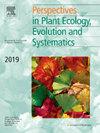超常:仙人掌分生组织中的巨人症、怪物和生长控制
IF 2.9
3区 环境科学与生态学
Q1 ECOLOGY
Perspectives in Plant Ecology Evolution and Systematics
Pub Date : 2025-08-28
DOI:10.1016/j.ppees.2025.125889
引用次数: 0
摘要
仙人掌是一种多种多样的多肉植物,几个世纪以来一直吸引着植物学家和爱好者。它们独特的特征和对干旱环境的适应使它们成为迷人的研究对象。研究仙人掌的一个重要原因是其茎尖分生组织(SAM)在发育过程中的特殊变化,如巨型SAM的生长、确定性、结合力和二分分枝。研究仙人掌的这些过程可能会对控制正常和异常生长的潜在遗传和发育过程提供有价值的见解,并对它们在具有挑战性的环境中的适应性有更深入的了解。这篇综述将试图阐明仙人掌独特的SAM模式,并讨论“异常”生长模式是如何起源的,并产生了进化上的新奇。此外,我们将利用主要来自模式植物拟南芥的数据探索调节仙人掌SAM细胞分裂和分化的初步分子途径和遗传因素。大多数相关研究结果表明,与在拟南芥中观察到的情况相反,仙人掌幼苗在萌发后的分带是不完整的。此外,更大的地对空导弹被认为与更大的区域有关。WUSCHEL (WUS)、CLAVATA (CLV)和SHOOT MERISTEMLESS (STM)是很有前途的候选基因,可能有助于解释仙人掌SAM中的各种现象。为了了解仙人掌的形态发生机制,有必要寻找同源物并利用分子生物学技术,如互补分析。本文章由计算机程序翻译,如有差异,请以英文原文为准。
Beyond the norm: Gigantism, monstrosities, and growth control in cacti meristems
Cacti are a diverse group of succulent plants that have captivated botanists and enthusiasts alike for centuries. Their unique characteristics and adaptations to arid environments make them fascinating study subjects. One important reason to study cacti is the particular changes in the development of the shoot apical meristem (SAM), such as the growth of giant SAMs, determinacy, fasciation, and dichotomous branching. Studying these processes in cacti might provide valuable insights into the underlying genetic and developmental processes governing normal and abnormal growth and a deeper appreciation for their adaptability in challenging environments. This review will attempt to shed light on the distinctive cacti SAM patterns and discuss how “abnormal” growth patterns might have originated and given rise to evolutionary novelties. Additionally, we will explore tentative molecular pathways and genetic factors that regulate the division and differentiation of cacti SAM cells using data primarily from the model plant Arabidopsis thaliana. Most relevant findings show that the zonation in cacti seedlings after germination is incomplete, contrasting with what is observed in A. thaliana. Additionally, larger SAMs are believed to be linked to larger zones. WUSCHEL (WUS), CLAVATA (CLV), and SHOOT MERISTEMLESS (STM) are promising candidates that may help explain various phenomena in the cacti SAM. To understand the morphogenetic mechanisms that establish zonation and size in cacti, it is necessary to search for orthologues and employ molecular biology techniques, such as complementation analysis.
求助全文
通过发布文献求助,成功后即可免费获取论文全文。
去求助
来源期刊
CiteScore
6.50
自引率
0.00%
发文量
28
审稿时长
67 days
期刊介绍:
Perspectives in Plant Ecology, Evolution and Systematics (PPEES) publishes outstanding and thought-provoking articles of general interest to an international readership in the fields of plant ecology, evolution and systematics. Of particular interest are longer, in-depth articles that provide a broad understanding of key topics in the field. There are six issues per year.
The following types of article will be considered:
Full length reviews
Essay reviews
Longer research articles
Meta-analyses
Foundational methodological or empirical papers from large consortia or long-term ecological research sites (LTER).

 求助内容:
求助内容: 应助结果提醒方式:
应助结果提醒方式:


